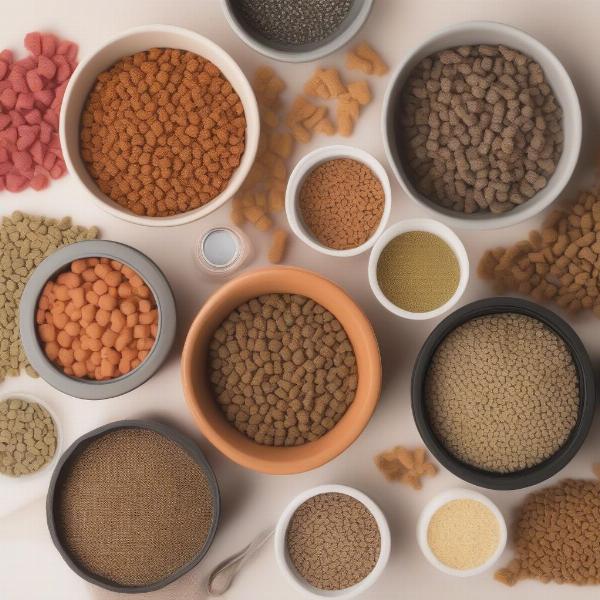Hearty dog food plays a crucial role in a dog’s overall health and well-being. Choosing the right food can be a daunting task, especially with the vast array of options available in the market. This article will guide you through the essentials of hearty dog food, helping you make informed decisions to provide your furry friend with optimal nutrition for a thriving life.
Understanding the Importance of Hearty Dog Food
A hearty diet is more than just filling your dog’s belly; it’s about providing the essential nutrients they need to thrive. Just like humans, dogs require a balanced diet consisting of proteins, fats, carbohydrates, vitamins, and minerals. Hearty dog food delivers these nutrients in the right proportions, promoting healthy growth, strong muscles, a shiny coat, and a robust immune system. Choosing a complete and balanced hearty dog food tailored to your dog’s age, breed, and activity level is vital for their long-term health and happiness.
Choosing the Right Hearty Dog Food: Decoding the Label
The pet food aisle can be overwhelming, with countless brands and formulations claiming to be the best. To make an informed choice, it’s crucial to understand how to decipher dog food labels. Look for the Association of American Feed Control Officials (AAFCO) statement, which confirms that the food meets minimum nutritional requirements. Pay close attention to the ingredient list, ensuring that high-quality protein sources like meat or fish are listed first. Avoid foods with fillers, artificial colors, flavors, and preservatives.
Different Types of Hearty Dog Food
Hearty dog food comes in various forms, including dry kibble, wet canned food, and freeze-dried options. Each type has its own advantages and disadvantages. Kibble is convenient, affordable, and promotes dental health. Wet food is often more palatable for picky eaters and can be beneficial for dogs with dental issues. Freeze-dried food retains more nutrients and flavor but can be more expensive. The best choice for your dog will depend on their individual preferences, dietary needs, and lifestyle.
Tailoring Hearty Dog Food to Your Dog’s Needs
A puppy’s nutritional needs differ significantly from those of an adult or senior dog. Puppies require higher levels of protein and calories to support their rapid growth, while senior dogs may benefit from lower-calorie diets and added joint support. Certain breeds may also have specific dietary requirements. Consulting with your veterinarian can help you determine the best hearty dog food formulation for your dog’s individual needs.
 Different Types of Hearty Dog Food
Different Types of Hearty Dog Food
Is Hearty Dog Food Worth the Investment?
Investing in high-quality hearty dog food can significantly impact your dog’s health and longevity. A well-balanced diet can prevent various health issues, reducing the need for costly veterinary care in the long run. While hearty dog food may be slightly more expensive than generic brands, the benefits in terms of improved health and well-being make it a worthwhile investment.
Conclusion
Choosing the right hearty dog food is a cornerstone of responsible pet ownership. By understanding your dog’s nutritional needs and learning how to navigate the world of pet food labels, you can provide your canine companion with the nourishment they need to thrive. Investing in hearty dog food is an investment in their health, happiness, and long life.
FAQ
- What are the key ingredients to look for in hearty dog food? High-quality protein sources (meat, fish, poultry), healthy fats, whole grains, and essential vitamins and minerals.
- How much hearty dog food should I feed my dog? Follow the feeding guidelines on the food packaging, but adjust portions based on your dog’s age, breed, activity level, and body condition.
- Can I mix dry and wet hearty dog food? Yes, many dog owners choose to combine kibble and wet food to provide variety and cater to their dog’s preferences.
- What are the signs of a food allergy in dogs? Common signs include itching, skin irritation, digestive upset, and ear infections.
- How do I transition my dog to a new hearty dog food? Gradually introduce the new food over several days, mixing it with their current food to avoid digestive upset.
- Is grain-free hearty dog food better for my dog? Not necessarily. While some dogs may benefit from a grain-free diet, others may thrive on grains. Consult your veterinarian for personalized advice.
- How often should I change my dog’s hearty dog food? As long as your dog is healthy and enjoys their current food, there’s no need to change it frequently. However, if their dietary needs change (e.g., due to age or health conditions), switching to a more suitable formula may be necessary.
About ILM Dog
ILM Dog is your trusted international resource for all things dog-related. We provide expert advice on dog breeds, health, training, nutrition, grooming, and much more. From puppy care to senior dog support, we’re here to help you navigate every stage of your dog’s life. Contact us at [email protected] or +44 20-3965-8624 for all your canine care needs. Visit us at ILM Dog for more valuable insights and resources.